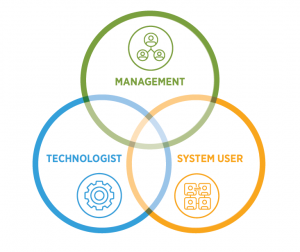July 13, 2020
This blog it the first of a three-part series on QMS implementation best practices. Sign up for our blog to receive parts two and three.
Even after decades of eQMS availability, a staggering number of projects still suffer when the QMS implementation team isn’t right, ready, and responsible. Regardless of your QMS software solution, organization size, or the number of quality processes automated, a common element of successful QMS implementations is strong team organization and management. Implementing an electronic quality management system isn’t simple, but it doesn’t need to be overcomplicated or disconnected if you follow some core practices.
Build an Effective QMS Implementation Team
Even before you start to evaluate quality management solutions, build your team, and solidify executive sponsorship from project inception. The team’s commitment will ultimately contribute to a large part of a QMS success or failure. Leadership must support the quality vision and communicate that vision across the organization.
Form your internal team with representation from management, technologists, and the user community. Bear in mind that team members will be spending extra time and energy outside of their standard workload, so be sure to secure management buy-in from the start. Remember, the more time each member can dedicate to the project, and the more realistic the timelines, the less likely they are to feel overwhelmed and become disillusioned.
- Management: Management is tasked with understanding and communicating the quality vision. For example, how will the system benefit our organization? Our stakeholders? Our customers? Management oversees the development and delivery of the project plan and are the “champions” of quality management transformation as a company culture. Educating the organization on the positive change ahead should be consistent and frequent.
- Technologists: The technologist(s) will be working in alignment with the QMS vendor’s professional services group. They will oversee design and control, test, audit, and monitor the software system. A tech team may require technical expertise from multiple disciplines. For example, a team implementing CAPA and change control management system for a medical device manufacturer might require knowledge of design and development, supplier management, and FDA regulatory compliance.
- System Users: Involve your users early; they are your “ambassadors.” These are the people who live and work in the system. Power users provide invaluable input throughout the implementation. It is a consistent error to wait to solicit system user suggestions and revisions too late downstream; it will lead to project delays and added expense. Engage them early and often.
Assign an equal weight to the requirements and concerns of each group. Also, share the big picture and support inclusiveness and the exchange of information.

Solicit Suggestions and Opinions Early
Even prior to starting software evaluations, stakeholders will want a voice. While it may be tempting to shrug off the landslide of suggestions from outside the implementation team, let it happen early in the process. Encourage the quality chain and leadership to express their opinions and give feedback on their vision of a quality system.
It may seem overwhelming to digest so much information. However, your team will almost certainly gain some very good insights. These insights will help you develop a better understanding of the requirements you need in your software and your processes.
Leverage Outside Quality Management & Industry Expertise
Gain valuable input from experts that have “been there and done that” and have a deep process and industry expertise.
Vendors: Learn from your QMS software provider. They have implemented the most complex quality and compliance systems. Their insight into the implementation of QMS systems is tested and invaluable.
Quality Organizations and Industry Forums: Dive into the deep pool of global quality standards organizations and industry-specific organizations with deep insight into best practices in the application of quality and regulatory standards.
Conclusion:
One of the most critical elements of implementing a quality management software solution is how you form and engage your implementation team. Create a strong team that not only contributes to the process design, testing, and rollout. Engage them to becomes the system champions and set the bar high for future expansion of your quality management system software. Inevitably, the commencement of your first automated QMS will have a lasting impact on the perception of your current and future commitment to a quality vision.
AssurX, EQMS, FDA Compliance Software, Quality Management System, Quality Management Software


